Henrik Schopmans
opXRD: Open Experimental Powder X-ray Diffraction Database
Mar 07, 2025Abstract:Powder X-ray diffraction (pXRD) experiments are a cornerstone for materials structure characterization. Despite their widespread application, analyzing pXRD diffractograms still presents a significant challenge to automation and a bottleneck in high-throughput discovery in self-driving labs. Machine learning promises to resolve this bottleneck by enabling automated powder diffraction analysis. A notable difficulty in applying machine learning to this domain is the lack of sufficiently sized experimental datasets, which has constrained researchers to train primarily on simulated data. However, models trained on simulated pXRD patterns showed limited generalization to experimental patterns, particularly for low-quality experimental patterns with high noise levels and elevated backgrounds. With the Open Experimental Powder X-Ray Diffraction Database (opXRD), we provide an openly available and easily accessible dataset of labeled and unlabeled experimental powder diffractograms. Labeled opXRD data can be used to evaluate the performance of models on experimental data and unlabeled opXRD data can help improve the performance of models on experimental data, e.g. through transfer learning methods. We collected \numpatterns diffractograms, 2179 of them labeled, from a wide spectrum of materials classes. We hope this ongoing effort can guide machine learning research toward fully automated analysis of pXRD data and thus enable future self-driving materials labs.
Symmetry-Aware Bayesian Flow Networks for Crystal Generation
Feb 05, 2025Abstract:The discovery of new crystalline materials is essential to scientific and technological progress. However, traditional trial-and-error approaches are inefficient due to the vast search space. Recent advancements in machine learning have enabled generative models to predict new stable materials by incorporating structural symmetries and to condition the generation on desired properties. In this work, we introduce SymmBFN, a novel symmetry-aware Bayesian Flow Network (BFN) for crystalline material generation that accurately reproduces the distribution of space groups found in experimentally observed crystals. SymmBFN substantially improves efficiency, generating stable structures at least 50 times faster than the next-best method. Furthermore, we demonstrate its capability for property-conditioned generation, enabling the design of materials with tailored properties. Our findings establish BFNs as an effective tool for accelerating the discovery of crystalline materials.
Temperature-Annealed Boltzmann Generators
Jan 31, 2025



Abstract:Efficient sampling of unnormalized probability densities such as the Boltzmann distribution of molecular systems is a longstanding challenge. Next to conventional approaches like molecular dynamics or Markov chain Monte Carlo, variational approaches, such as training normalizing flows with the reverse Kullback-Leibler divergence, have been introduced. However, such methods are prone to mode collapse and often do not learn to sample the full configurational space. Here, we present temperature-annealed Boltzmann generators (TA-BG) to address this challenge. First, we demonstrate that training a normalizing flow with the reverse Kullback-Leibler divergence at high temperatures is possible without mode collapse. Furthermore, we introduce a reweighting-based training objective to anneal the distribution to lower target temperatures. We apply this methodology to three molecular systems of increasing complexity and, compared to the baseline, achieve better results in almost all metrics while requiring up to three times fewer target energy evaluations. For the largest system, our approach is the only method that accurately resolves the metastable states of the system.
Conditional Normalizing Flows for Active Learning of Coarse-Grained Molecular Representations
Feb 02, 2024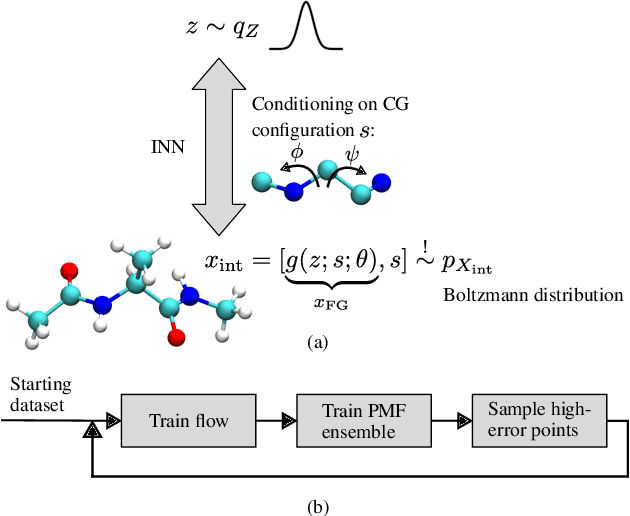
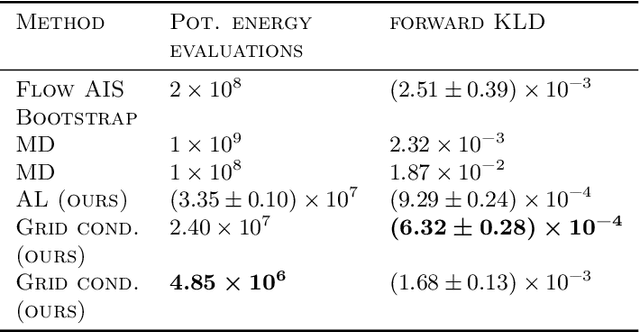
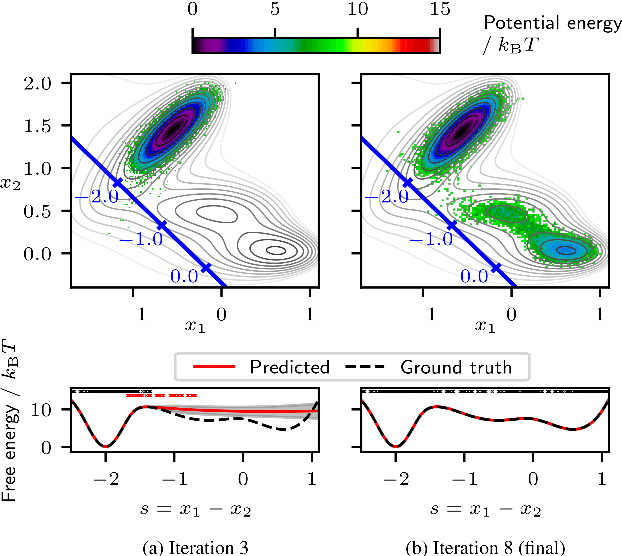
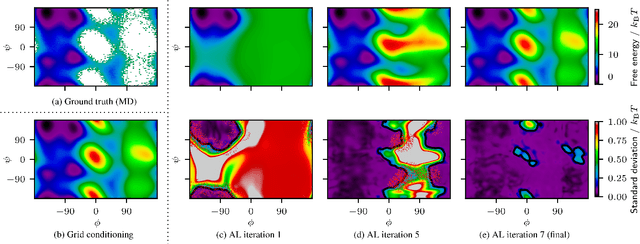
Abstract:Efficient sampling of the Boltzmann distribution of molecular systems is a long-standing challenge. Recently, instead of generating long molecular dynamics simulations, generative machine learning methods such as normalizing flows have been used to learn the Boltzmann distribution directly, without samples. However, this approach is susceptible to mode collapse and thus often does not explore the full configurational space. In this work, we address this challenge by separating the problem into two levels, the fine-grained and coarse-grained degrees of freedom. A normalizing flow conditioned on the coarse-grained space yields a probabilistic connection between the two levels. To explore the configurational space, we employ coarse-grained simulations with active learning which allows us to update the flow and make all-atom potential energy evaluations only when necessary. Using alanine dipeptide as an example, we show that our methods obtain a speedup to molecular dynamics simulations of approximately 15.9 to 216.2 compared to the speedup of 4.5 of the current state-of-the-art machine learning approach.
Neural networks trained on synthetically generated crystals can extract structural information from ICSD powder X-ray diffractograms
Mar 24, 2023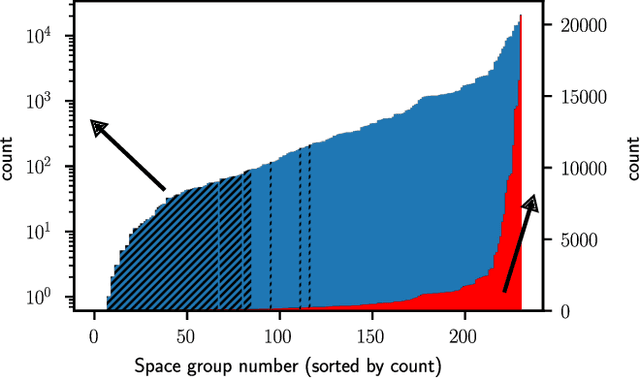
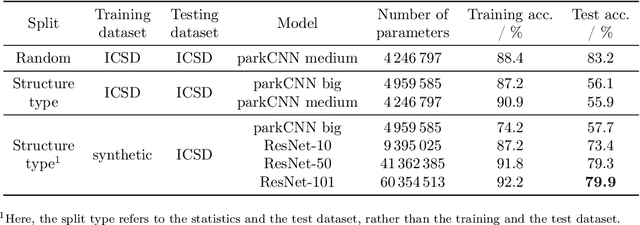
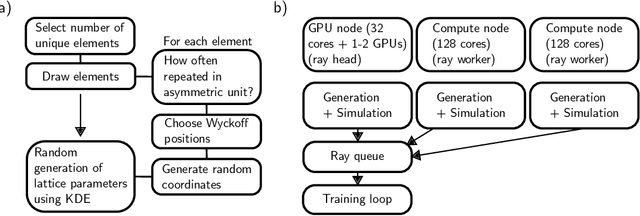
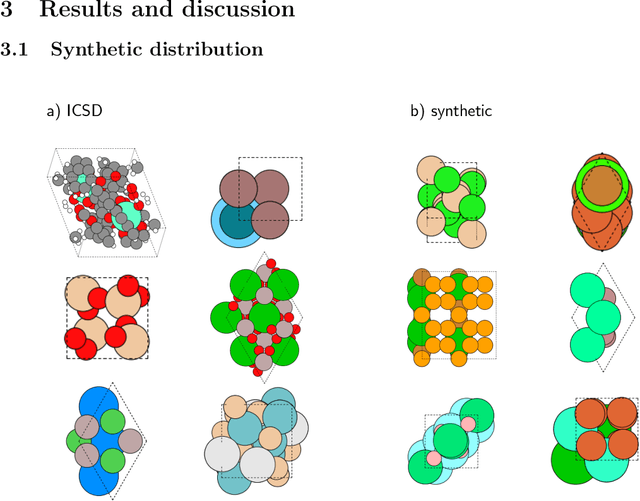
Abstract:Machine learning techniques have successfully been used to extract structural information such as the crystal space group from powder X-ray diffractograms. However, training directly on simulated diffractograms from databases such as the ICSD is challenging due to its limited size, class-inhomogeneity, and bias toward certain structure types. We propose an alternative approach of generating synthetic crystals with random coordinates by using the symmetry operations of each space group. Based on this approach, we demonstrate online training of deep ResNet-like models on up to a few million unique on-the-fly generated synthetic diffractograms per hour. For our chosen task of space group classification, we achieved a test accuracy of 79.9% on unseen ICSD structure types from most space groups. This surpasses the 56.1% accuracy of the current state-of-the-art approach of training on ICSD crystals directly. Our results demonstrate that synthetically generated crystals can be used to extract structural information from ICSD powder diffractograms, which makes it possible to apply very large state-of-the-art machine learning models in the area of powder X-ray diffraction. We further show first steps toward applying our methodology to experimental data, where automated XRD data analysis is crucial, especially in high-throughput settings. While we focused on the prediction of the space group, our approach has the potential to be extended to related tasks in the future.
 Add to Chrome
Add to Chrome Add to Firefox
Add to Firefox Add to Edge
Add to Edge